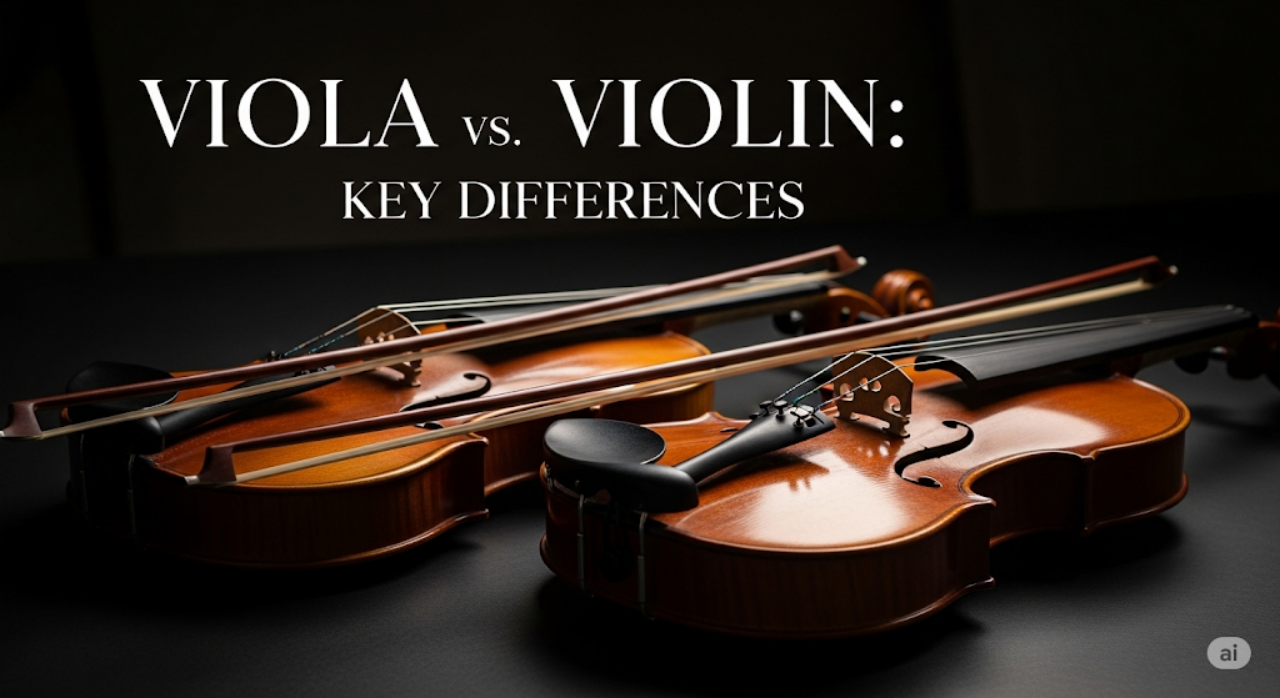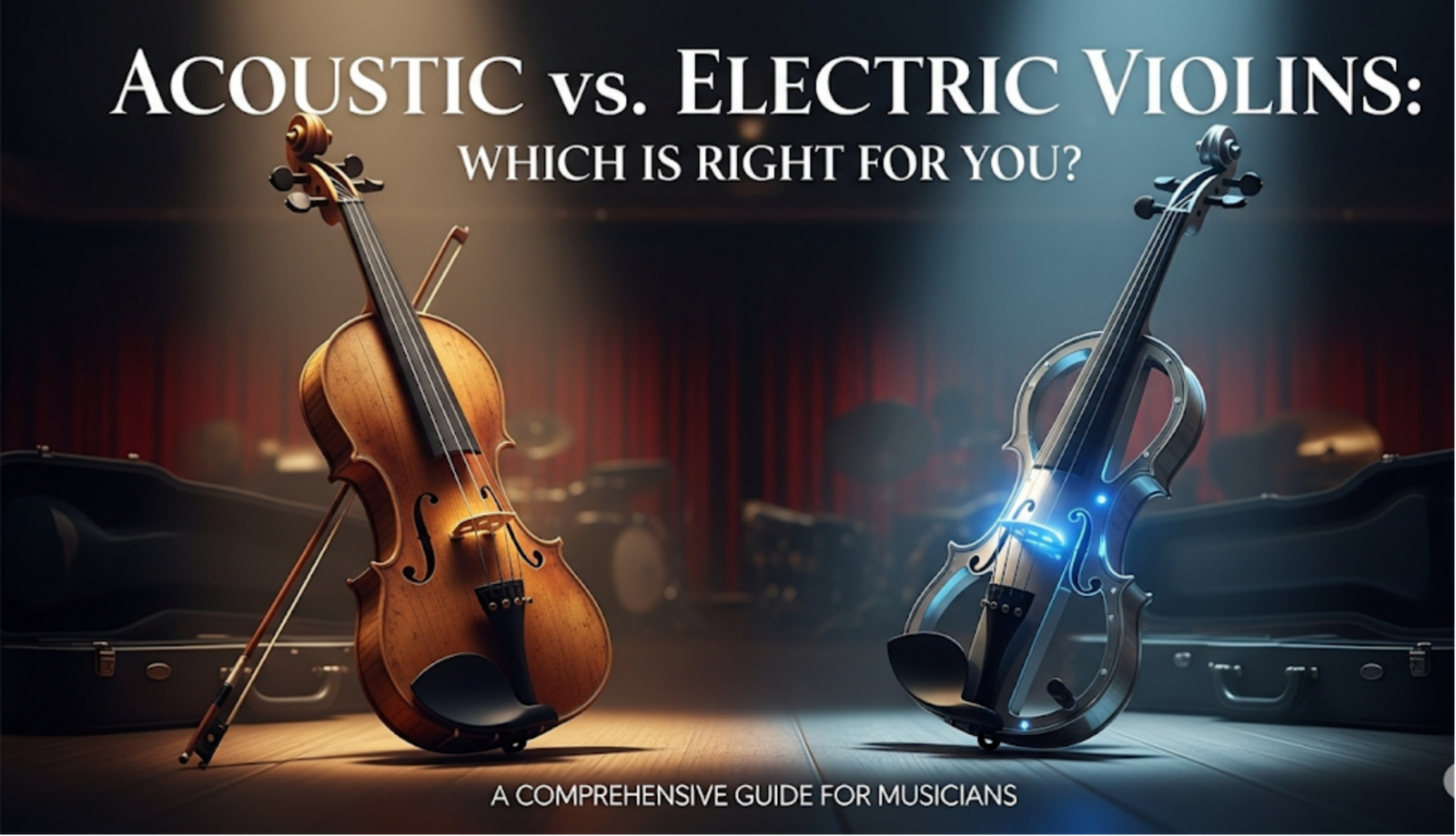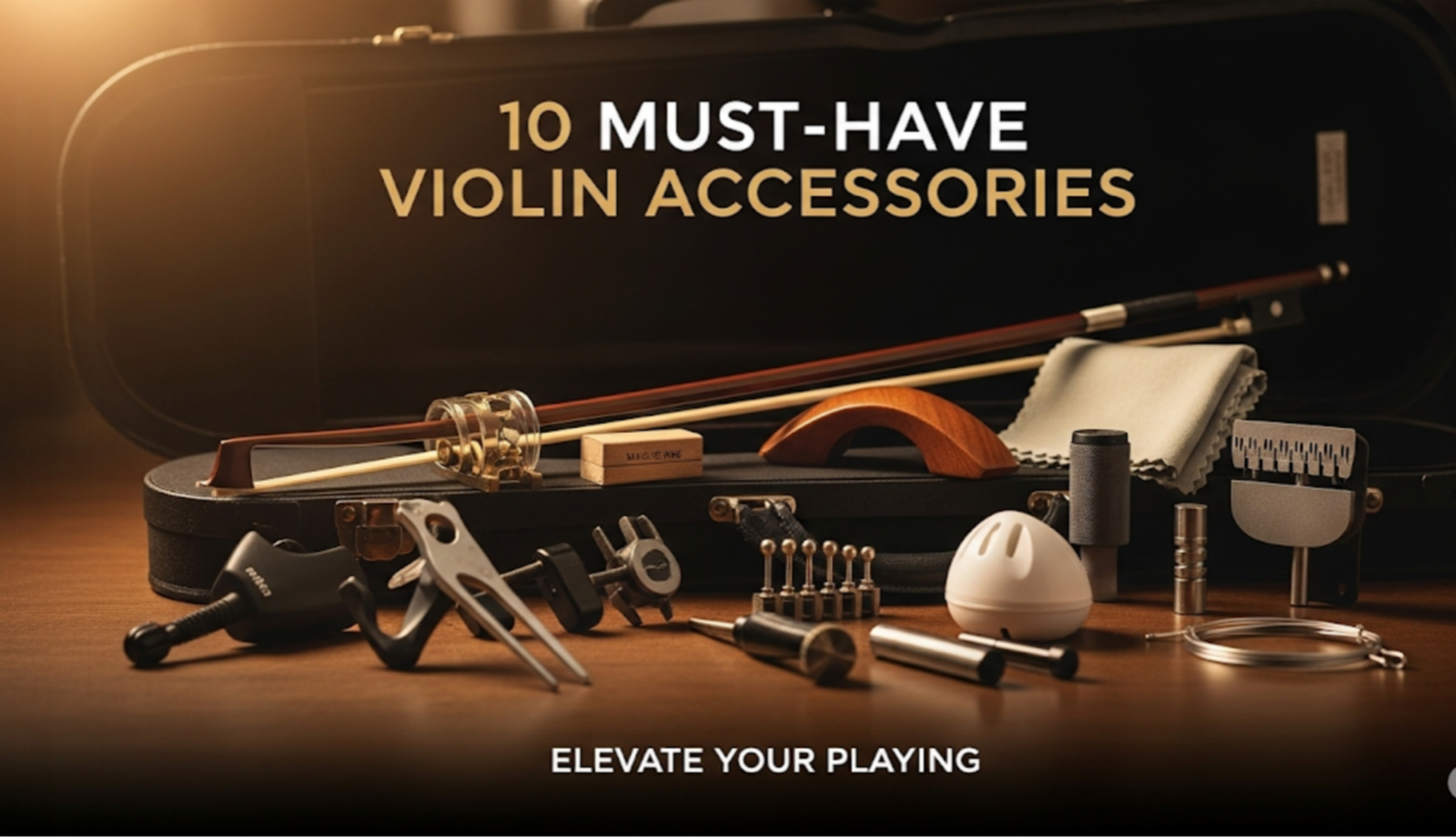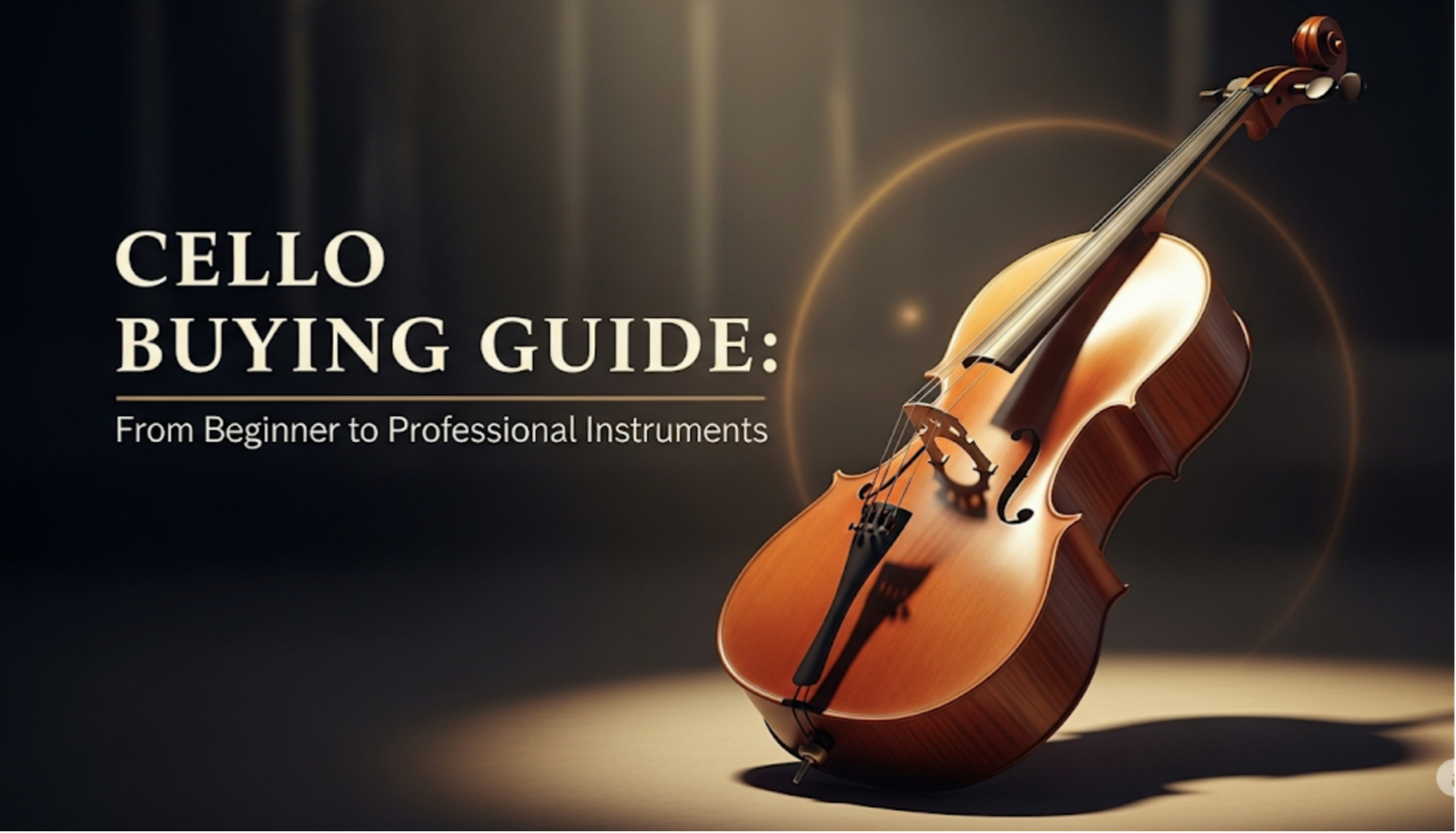A violin and violin look similar visually, but both string instruments differ towards the music they play. Violas are larger than violins. In fact, a typical violin is roughly fourteen inches, while a viola usually comes in the range of fifteen to eighteen inches. The sizes are very different and this makes their sound so, the violins’ sharp and bright intricately melodic lines are ideal for a solo, while the viola’s warm, mellow tones give depth to the harmonies.
The tuning of violins (G-D-A-E) and violas (C-G-D-A) and notation (violin use treble clef; viola reads alto clef) are important differences. The choice you make greatly affects many things: the comfort of your finger stretches, the roles of your instrument – violin usually takes lead, viola often bridges the rhythm and harmonic elements.
I’ll help to simplify your choice of suitable models for first players.

What are the differences in the sizes of viola and violin?
Violas are 15-18 inches long and deeper-bodied, while violins are 14 inches long. These impacts comfort as well as playability.
Comparing: Body length proportions
In general, violins have a 14-inch body, compact and agile. In contrast, violas range from 15 to 18 inches, and their longer ribs provide deeper resonance chambers.
Consequently, the size disparity impacts almost everything, including the dimensions of the cases as well as the players’ posture—violists have to lift their arms higher when bowing.
Effects of Weight Distribution
The viola’s larger size increases its weight by 6–10 ounces when compared to a violin. This increases the violas’ center of gravity, which requires strong shoulder support. While violinists enjoy lightly held violas for fast passages, viola players need to be careful as they may become fatigued quite quickly.
Differences with Fingerboard Spacing
Violas have larger fingerboards than violins because they are 1-2 cm wider than violins. This wider stretch separates strings for finger stretches, something which can be rather difficult for players with small hands. But violinists have really close spacing on the fingerboard, and play really fast, with the downside being the viola’s much richer sound.
What Gives Violin and Viola Their Unique Sound?
Violins are built for bright, piercing tones, suitable for first voices while warm mellow middle tones of the viola make them suitable for second voices.
Explaining Resonance of Tone.
A violin’s smaller body and a relatively higher pitch (G-D-A-E tuning) gives the violin a brilliance of tone that helps it to lead the orchestra. This is comparable to a soprano singer’s clarity. The viola’s thicker strings and larger body produce a tenor-like “woody” richness, thanks to its deep ribs and mellow timbre. The reason for this difference lays in the physics. The viola strings, when tuned C-G-D-A, vibrate slower than other instruments. Thus, they make deeper overtones.
Ensemble Sound Projection
Violins maintain their place as the leading instrument for melody lines. Their bright timbre and high pitch make them the easiest instrument to be heard in large halls and even drowned out orchestra.
Violas stand out exceptionally in blending both the cello and violin, serving as “inner voices” and adding a warmth to the mid-range. In the context of a quartet, the viola is often the backbone of the chord progressions. With a softer sound, the viola supports harmonics as it is far from a dominant soloist. A fun fact is that Berlioz used this to his advantage giving the viola’s prominent yet ghostly threads in Harold in Italy.
What is the reason for the different tuning systems for violas and violins?
For the case of violins, they tune to the higher G-D-A-E for captivating tunes, while violas serve as a C-G-D-A for deeper, warm, and harmonic filling. This is a perfect 5th apart, highlighting the essence of the violas and the violin’s purposes.
Standard tuning intervals
Both instruments follow the same interval pattern. The viola’s C string ( which happens to be the lowest string) is shifted into a lower range which translated to deeper pitches.
- Violin (G3-D4-A4-E5): The high E string allows for flashy techniques as harmonics in Paganini’s pieces.
- Viola (C3-G3-D4-A4): The C string allows for strong lower challege while rich chordal Brahms’s chamber music.
The reason for this tuning mismatch is not random. It would be a mismatch for each instrument’s body size (the viola’s body is larger) and string thickness (viola C-string is 30% thicker than violin G string).
Pitch range capabilities
The violin’s highest note, E7, easily surpasses the viola’s limit, A6, allowing the violin to shine on virtuosic solos. On the contrary, the viola’s lowest C3 allows it to reach notes that violins would no longer be able to catch.
- Violin Range: G3–E7 (soprano-tinged and bright)
- Viola Range: C3–A6 (alto or tenor-leaning, darker)
Clef differences between Violins and Violas
Violinists read treble clef (G clef) for higher notes exclusively, but violas use alto clef center(C clef) which has middle C as the focus. This is an unusual system that requires specialized sight reading.
Core Components of Alto clef
In contrast to the treble clef, in which middle C is below the staff, the viola’s alto clef positions middle C on the center line. This helps to ensure that the vast majority of notes that involve the viola are within the staff which avoids excessive ledger lines.
- Alto Clef Advantage: Readability for C3–A5 is optimized.
- Treble Clef Standard: The range of the violin (G3–E7) is exceedingly higher, but fits perfectly.
As an example:
- In alto clef, second space is G3which is the viola’s open G-string.
- In treble clef, second line is G4which is an octave higher.
Adjustments between instruments
Violinists switching to viola have an adjustment period of 3–6 months because of:
- Note Mental Remapping: Notes differ such as “F” sitting on the top line of alto clef and first space “F” in treble clef.
- Finger Placement Disorientation: Across clefs, the same finger position leads to different pitches.
- Repertoire Limitations: Beginner materials are primarily in treble clef, comprising 90%.
Pro tip: When practicing alto clef, consider it positioning on the lower clef. It will be easier if you think of “landmark notes” like middle C on the center line.
Does viola playing require different skills compared to violin playing?
Certainly! The viola is more demanding in terms of to the instrument requiring 30% more bow pressure to resonate its thicker strings, to yielding wider finger stretches (up to 20%) on the instrument.
Variations in bow pressure
To achieve the clarity of the tone on the viola, a greater arm weight is needed due to:
- String Thickness: Viola C-string is 0.80mm while the violin G-string is 0.60mm
- Bow Weight: Viola bows are heavier than violin bows at 70g compared to the 60g average.
- Sound Production: It is more “sluggish” than the violin due to the need of slower, fuller strokes (viola’s “pushed” legato vs. violin’s “bouncy” spiccato).
Pro Tip: A common stick thing for violists is to rotate their bow hold to the side for more equal weight.
Positions of the left hand
The scale of the viola is longer compared to the violin (15%+) which accentuates:
- Finger Spread: 3rd position is now 2cm wider (critical for Walton’s Concerto).
- Vibrato Motion: Slow, wider movements.
- Shifting Challenges: Positions requiring less or different muscle memories are now “farther away.”
Are There Distinctions Between The Looks Of Violins Bows And Viola Bows?
Alternating Between the two bows are called Violas, the bows are not different in terms of looks, but the two share a common need between the two to be more distinct.
Violin bows focus on agility which is essential for quicker sections, while viola bows are 10—20g heavier with broader ribbons in order to energize thicker strings. Each of these factors contributes to playability and tone production in different ways.
Weight and curvature specs
Viola bows are 70—75 grams, which is greater than the 58—62g range of violins, and includes a ribbon 1cm wider at 10—11mm, vs the 8-9mm of violin bows. The added weight is due to:
- Peranumbuin greater quantities and denser pernumbu wood, or carbon fiber cores
- Greater frog: bolster grip end of the bow
- Flatter camber: provides a lower string pressure while maintaining even tension.
With these weight distributions, violists can “dig in” without damaging the sound.
Impact on articulation
This leads to the following effects with viola bows:
- Legatois fuller—with C-string notes resonating well.
- Spiccatoexhibits less bounce than is common with violins.
- Bow changestend to be slower on account of weight driven momentum.
Former violinists find articulation clarity difficult to master and the responsiveness of the bow takes some time to get used to.
What are the viola and violin’s roles in orchestras?
Demanding roles for both strings, violins are the orchestra’s soprano voice, usually leading a melody, while violas serve as the cellos and violins. This functional partitioning generates a singular musical logic.
Section Positioning
Traditionally, the split of violins into sections (1st playing high melodies, 2nd supporting harmonies) placed 1st violins on the conductor’s left, with “2nd violins” at the conductor’s right. The violas are placed in the center right. They merge musically with the low strings (cellos and basses) and the high strings (violins). This central position enables the violas to reinforce the cello bass lines and blend with the counter melodies played by the violins. This blend is a delicate counterpoint to their mid-range timbre.
Repertoire Examples
Classically, the role of violinists in pieces is often to stand out in soloistic roles like Tchaikovsky’s Violin Concerto, which has soaring themes. Voilas often stand out equally like in symphonies, in their role as a harmonic pillar supporting the melodic structure. Berlioz’s Harold in Italy prominently features the rich C-string of the viola, functioning as the harmonic foundation. In Mozart’s symphonies, the violas often play the role of doubling the cellos an octave above which adds contour to the texture in a way that violins cannot.
What genres best suit violas vs violins?
Both instruments are flexible but violins take the lead in classical solo performances and folk music while violas take the lead in chamber groups and movie scores. This specialization highlight their distinct timbral qualities.
Solo Versus Ensemble Strengths
Primarily, the violins hold the concero position as the central part of the orchestras, their brilliant high register dominating the rest in concertos performed by Paganini or Sibelius.
As for violas, they do best in close-knit groups. They are warm and emotional, blending in to string quartets like in Mozart’s “Viola Quintets” and film soundtracks. John Williams features violas in sad themes. The piercing clarity of the violin compliments fiddle tunes and gypsy jazz, whereas the contemporary and avant-garde chamber works are enriched with the viola’s darker tone.
Should Beginners Choose a Viola or a Violin?
In the end, however, both pathways are viable. While violins afford greater self-study opportunities, violas offer greater opportunities in niche ensembles. Each instrument has its pros and cons for new players.
Comparison of learning curves
To start off with, violins are easier for children to play as they are smaller in size. On the other hand, violas have a simpler alto clef reading in the early stages when compared to the violin’s high-position treble clef. While the viola’s thicker strings do command more bow control, they do not have to deal with the violin’s upper register pitch precision challenges.
Availability of learning materials
In practical terms, violin students have access to method books like Suzuki and Essential Elements as well as a plethora of online tutorials which far exceeds the amount available to viola students. Viola students have to make do with violin materials or find a niche specialized viola teacher in high demand, making the scarcity of skilled violists in youth orchestras and scholarships paradoxical.
What is the historical evolution of violas and violins?
Traditionally, both instruments were developed in 16-th century Italy, but violins were put to use earlier as soloists, giving them a head start as violins were refined first.
This divergence shaped their roles in music.
Innovations luthiers made
Cremonese masters such as Stradivari improved elements of the violin such as its body length, and its f-holes, as well as its projection. Later, viola makers like Gasparo da Salò experimented with larger dimensions, between 17 inches to 18 inches, to improve the resonance of the C-string. Standardization did not come until the 20th century. The contemporary viola’s design balances C-string resonance and ease of playing. Modern violas, in contrast, are the results of centuries of design alterations.
Where to buy low price starter instrument for learning?
Ariose violin offers thoroughly adjusted student grade violas and violins which are properly scaled for the players. They start in grade to eliminate the common shortcomings of ease of action and sound associated with beginner instruments.
Beginner viola suggestions
Getting the right viola will require taking into account its size, tone, and playability. Ariose Violins made available to them published a viola buying guide for beginners that puts the process to ease:
- 1/2 to 4/4 sizesfor children and teens up to 12 and adults.
- Crafted from hand carved sprucegiving them a warm tone and rich resonance.
- Prelude stringsthat are responsive to the bowing motion and thus, ease to play.
Their curated selection performs well and does not suffer from the cheap student viola thick C string problem.
Consultations for violin size
Using the right instrument for playing right and bad habit will not lead to. Ariose Violin has the Violin Sizing Tool which offers a match to player to:
- 1/16 to 4/4 sizesare offered based on the measurement of arm length.
- Light modelsadjustable to the age of the player which are tailored to the younger users.
- Ebony fittingsenhance resilience to wear and improve tuning stability.
“Try before you commit—Ariose Violin’s trial program lets you test instruments risk-free for 7 days.”
FAQs
Can violinists smoothly shift to playing the viola?
Yes, though they will have to spend 2-6 months adapting to the alto clef, finger spacing, and wider dimensions.
To ease the transition, begin with scaled etudes (e.g. Kreutzer, but a fifth down) and practice redistributing bow weight. For viola C string, 30% more pressure than what the violin G string requires, is essential.
Do violas come at a higher price than violins?
In contrast, Student violas cost 10-20% more. This is due to using larger materials. For the professional tiers, they price similarly.
A reliable beginner viola runs $500–$800 (vs.
$400–$700 for violins). Buy solid wood; plywood violas are difficult to project.
Which instrument has higher demand in orchestras?
Violists face less competition; 30% of orchestras report shortages compared to the oversupply of violinists.
Violists are aggressively recruited by youth orchestras. Some organizations will even provide complimentary loaner instruments.
Conclusion: Viola vs Violin – Summary Highlights
In the case of violins (14”) and violas (15-18”), the former plays bright and agile melodies, usually in treble clef, while the latter performs resonant, warmer harmonies in alto clef. Bowing, string tension, size etc. requires different skills for different instruments. Teaching materials for violins are more available for beginners. Nevertheless, violas offer unique ensemble opportunities that are less competitive. A good design minimizes frustration while maximizing engagement, however, keep in mind.



